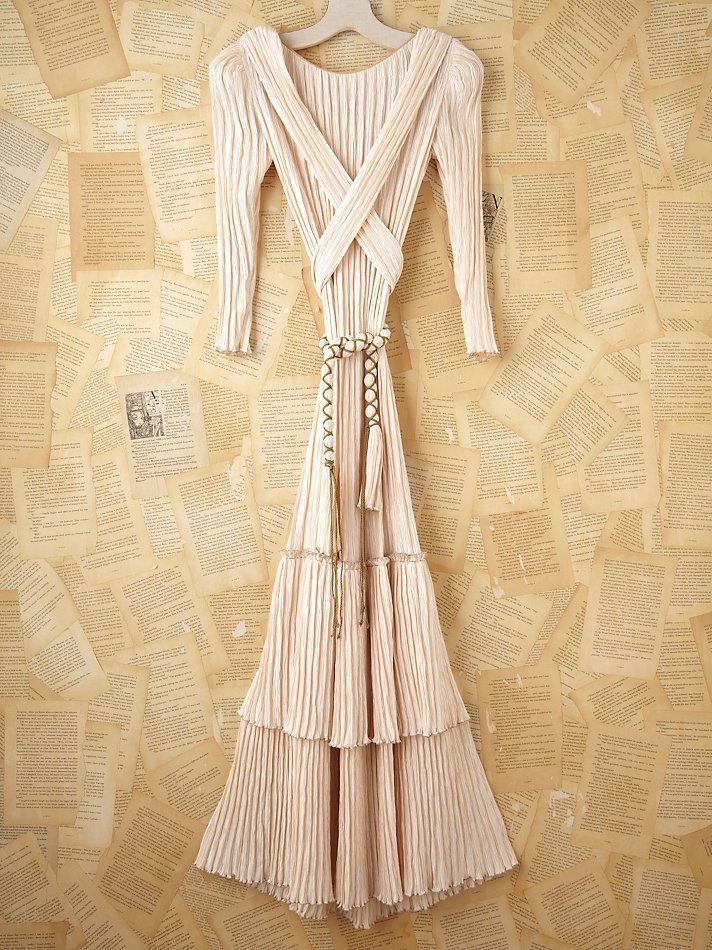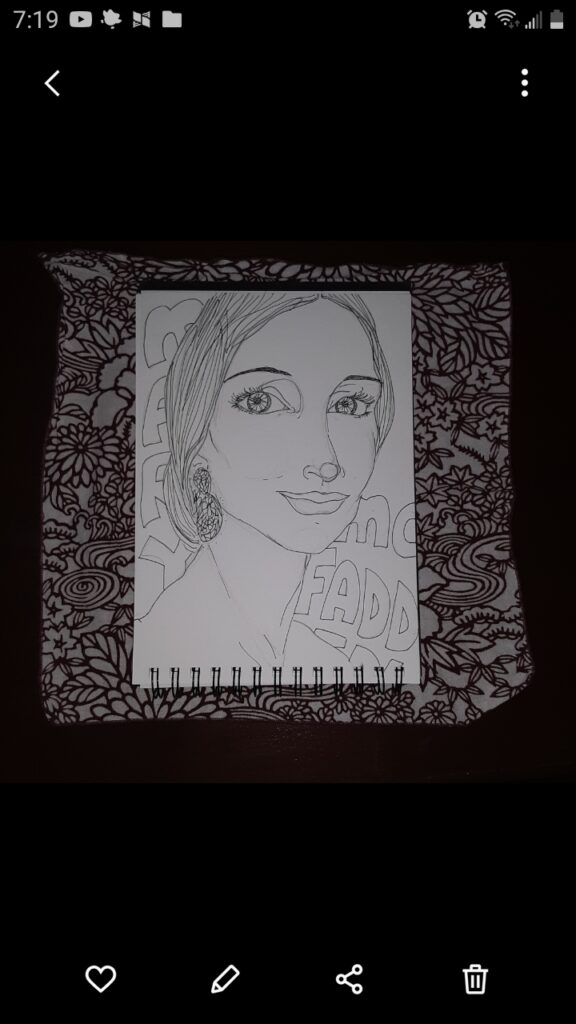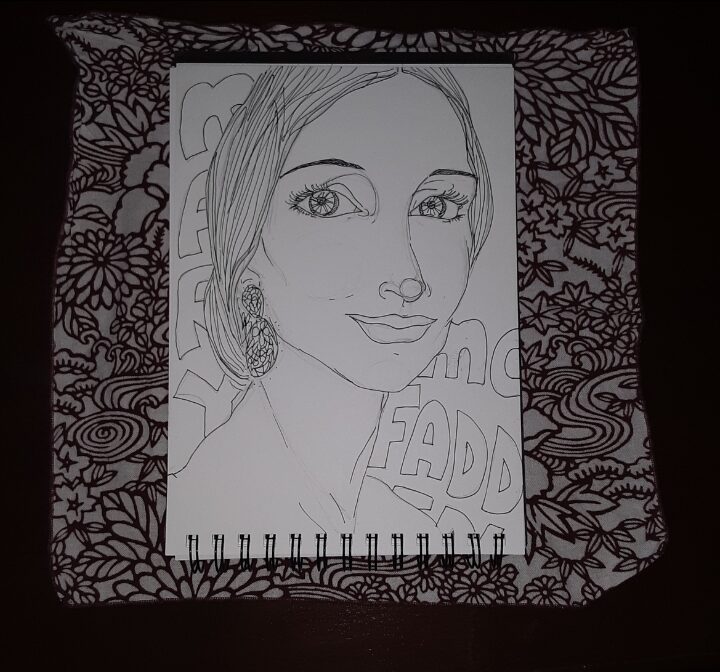By Angel Brynner.
* This is an excerpt from an interview that will be published in its entirety in the upcoming Globalboho travelogue.
This is Angel Brynner. Interviewing Mary McFadden for the Global Boho Project.
First question. What is your name?
Hi. My name is Mary McFadden.
How do you define yourself?
Well…now~ I’m an older woman, a mother, and I’m retired. So I’m seeing the world.
How do you think others define you?
Others define me by my clothes.
How would you describe your style as a designer?
Well, I like very feminine ladies clothes, and I work in a fabric called Marii pleating that I developed, which is a permanent pleat. And it’s a wonderful product because it requires no maintenance whatsoever- it’s going to endure forever.
What brought you to your pleating process? What inspired you?
Well, first of all, I needed a product that was going to be permanent. And I had to find a fiber that I could put through the heat transfer process. It took me a long time before I found my marii pleating, and I mean I experimented with maybe hundreds of fibers. It is an incredibly wonderful product, not only for travel but due to its permanence it is a very sustainable product that requires no maintenance.
You’re also known for a lot of prints–
If you can find the right polyester you can print on it. The polyester aspect is what makes it permanent but sometimes you can’t print on polyester. It took a long time to find the right one, and usually the cheapest ones were the best possible( which is rarely where we start in fashion)for printing and for the heat transfer process.

I primarily knew of you as a designer, but if I remember correctly you have also done fashion editing, right?
Right. I actually began as a Fashion editor. I still do some fashion editing.
What magazines do you work for?
I started off with Vogue. I was friends with Alex Lieberman and Diana Vreeland, and they gave me the job of Vogue South Africa. So I got to see South Africa through the eyes of Vogue, in both Cape Town and also Johannesburg- and that was fun. That was a great, fun project. Because not only did I get to see all of Africa but I also was inspired by all of my experiences in Africa via Vogue when it came to fashion.
Was your fashion (production and fabrication) business originally based in Africa?
No, I hadn’t started to make my own clothing yet. I started another business there. I married the director of the National Gallery, in Zimbabwe and started this African serpentine workshop in Nanyang province. We had about 20 African artists as part of the workshop but no quarries on the property, so I’d have to go sometimes half a day to different quarries to bring stones back for the artists to carve into beautiful serpentine sculptures. And I sold them all over the world. I still do.
Did you design the sculptures? Like, did you say “this is what the design is” to the artists?
I just let them design what they wanted to. They had been doing it for many years. They were way beyond me at that time in terms of being adept working in serpentine.
You did jewelry design too, right?
Yes, but that was totally separate from this. Later.
How would you describe what you did as a fashion editor?
Well, first of all, you have to find a designer to write about! Some of the unique designers I had a chance to meet and write about are still alive today.
I know! Life is so surreal sometimes! For me to have the honor to interview you is blowing my mind because you’re one of the reasons that I actually went into fashion a lifetime ago. I fell in love with pleating. Because of Egypt. Then Maison Fortuny when I was 15 or so. Then I fell in love with your work in college- and it was wild that your work with pleats and polyester dovetailed into the path of Issey Miyake, one of my favorite designers- the reason my fashion path led to Japan. Even though I’ve moved into art and writing, I’m very, very happy to get the chance to talk with you.
(*taking that fangirl moment because OMG* Mary f ureaking McFadden was and still is the vanguard of what morphed into the geist of all things Globalboho*)
You’re now based in New York City, and you’ve traveled all over the world. You’ve had many opportunities and been able to travel via many careers. Where is your favorite place, and what was the first trip that you took that got you hooked on traveling?
When I moved to Africa and became editor of Vogue South Africa that moved me around the world a LOT. And then, when I came back, I became special projects editor of American Vogue, and that moved me around the world a lot more doing stories. Any business I did always took me around the world. And also~ I could write any story I wanted. My Editors didn’t reject it. So I could go to Central Asia, to Thailand, to do a story.
What are some more of your favorite places to go?
Everywhere! To China and Japan, like, I was just seeing a new map of the latest trek on the Cunard line( the luxury cruise line https://www.cunard.com/en-us). They now have a ship that goes around the island of Japan. It’s about maybe a week and a half and it also includes a stop off in Burma. So you could do that and see all of Japan. Japan, for me, is a very mysterious country, mainly because I can’t speak the language.
It definitely helps. Even though a lot of Japanese studied English in school, they often are shy or wary of speaking it and it can keep kind of a buffer between you and the culture. But that trip sounds amazing. Is that[ via cruises] your favorite way to travel now?
I’ve been traveling via ship for ages, from the beginning! I’ve been invited on cruises, to lecture(for example). And then once I got to wherever I had been invited, I picked up my own information and wrote a story about the country.
That’s kind of what I have done with the Globalboho project all these years. People inside fashion see the fashion DNA in how I move. It’s old-school, fashion soak-up the spirit of a place style. I’m sure you’ve been to Venice before this trip, right?
This is my first time to Venice.
Okay- Wow! What do you think? Even though it’s like post COVID, the energy is kind of what it is. It’s not that different.
I really like this area. I really enjoy it here. And of course, my daughter [the artist Justine Harari] has a lot of friends here.
On this side of the vortex they have a room that’s dedicated to Jim Morrison and then they have a room that’s dedicated to Dennis Hopper, the actor. You’re staying in the Hopper suite, right?
Yes. & I knew him.

Well, what have you done on your first time in Venice?
I’ve had a chance to see a lot shops, the Venice canals, Lots of walking up and down the beach. There’s so much that all comes together in this area.
Has she taken you over to the skate park so you can see the murals by the graffiti artists?
I haven’t done that yet.
I hope she takes you to see that- artists come from all over the place. The murals are temporary, so whoever comes in can cover what you do. I’ve known artists from Peru who’ve come up and just done a chunk of the mural like it was a pilgrimage. Sometimes they get more allegorical, but it’s mostly graffiti. Also, down on Venice Boulevard there’s a gallery called LA Louver, and it always has amazing work. And there are a lot of artists based here who participate in this thing called Burning Man that happens out in the desert. They build out this city-
I’ve wanted to go to that!
(brains all over the place at how badassed it is that Mary McFadden, the original High Priestess of High Fashion has been piqued by all things Burning Man too)
They’re thinking that they may not be able to do it this September, but they may be able to do it again next September[ They HAVE done a rogue burn of 10000 badasses after all]. But you can be walking on the boardwalk and you might run into an installation that someone just had to get out of themselves. This is a really interesting vortex for all of that. Let me see. Just two more questions. Is this your first trip since the pandemic?
I’ve made a few trips, stateside.
Okay. How would you described the atmosphere while you are traveling? Because a lot of people are nervous about getting back on the road. Did you have to take a lot of preparation? Do you have any advice for people who would like to travel but are scared to step out of their comfort zones and go and explore the world again?
I really didn’t notice anything different. But my advice would be to just buy the plane ticket. A cruise ticket. Whatever. Just DO it.
Yeah! I mean, straightforward. I do have one more question. You were a part of the CFDA-
A President!
There’s an unspoken understanding that fashion is one of the American industries where, as a woman, you could come in and make your own way, even ages ago. Do you keep up with everything that’s going on in the industry now?
No. Too lazy. It is exhausting.
But what made you all decide that the industry needed it?
Well, Eleanor Lambert was really the founding member- the idea behind it was hers. And we worked for her. She was a Press agent[ and placed on the National Endowment for the Arts under Johnson]. And she handed the CFDA to me.
One of my mentors in Japan was one of the founders of the council of fashion designers in Japan[CFDJ]. Were the different offshoots connected?
Everyone was standalone. Everyone was on their own, although I think that they may have gotten some ideas from the American operation.
How did you get to this “Globalboho” project from fashion? she pointed at the globalboho sweatshirt I was wearing)
I used to be a small menswear designer, and I traveled back and forth between New York and Japan. I was already addicted to traveling but that amplified it. When I stopped designing, I still created collages for mood boards to shorthand whatever I was feeling or seeing. I turned that into my fire. My illustration style is still fashion illustration, lots of Antonio & Thierry Perez love woven into a Lil comic book style. last.

My fashion shows were club parties set in the world I saw for the clothes. When I stopped doing fashion shows, I kept building out the stories and the stories became the art installations and people would come into raw spaces in the same way. It helped me write. It’s been a love labor but I’ve been having fun.
I can tell you’re having a blast. You’ve really created your own light!
But that I learned from people like you. When I came up, fashion designers were ambling all over the world.We lived! Went and saw things! Did things! A kid from Ohio never had any inkling of the beauty that was out there in the world unless we saw it in Vogue or an Elle magazine, or draped across an aunt addicted to those windows out into the world. So that’s where all of this started for me. And seeing all of the the fabrications, the designs, the costumes that the people of this planet don just doing their thing… like fashion opened this entire planet for me and gave me the opportunity-
…To have a lot of fun!
Yeah…But nevermind me- You’ve had an amazing life! And you still are having an amazing life! And that’s just so wild to me. And I’m sitting here Devouring your outfit today–
This Jacket is about four days old- I found it in a shop here. This here came from Bali. This pleated situation, an experiment with pleating- and these pants?
They look like real Harem pants-
They are!
You’re just literally Globalboho- globally Bohemian- It’s everything. And it honors everything, and the colors are just like- I’m just sitting here, in arthead love looking at you! You look fantastic.
…The clothes look fantastic-
No, like you look like you’re glowing!You’re highbeaming! And it’s stunning–
I found this amazing hat here in a shop two days ago. And it just pulls all of it together. I already had a good one before- You’re very kind to spend time interviewing me-
I’m honored to even have the opportunity to! I really am. Well, that’s pretty much it. I appreciate your time and willingness to do this.
